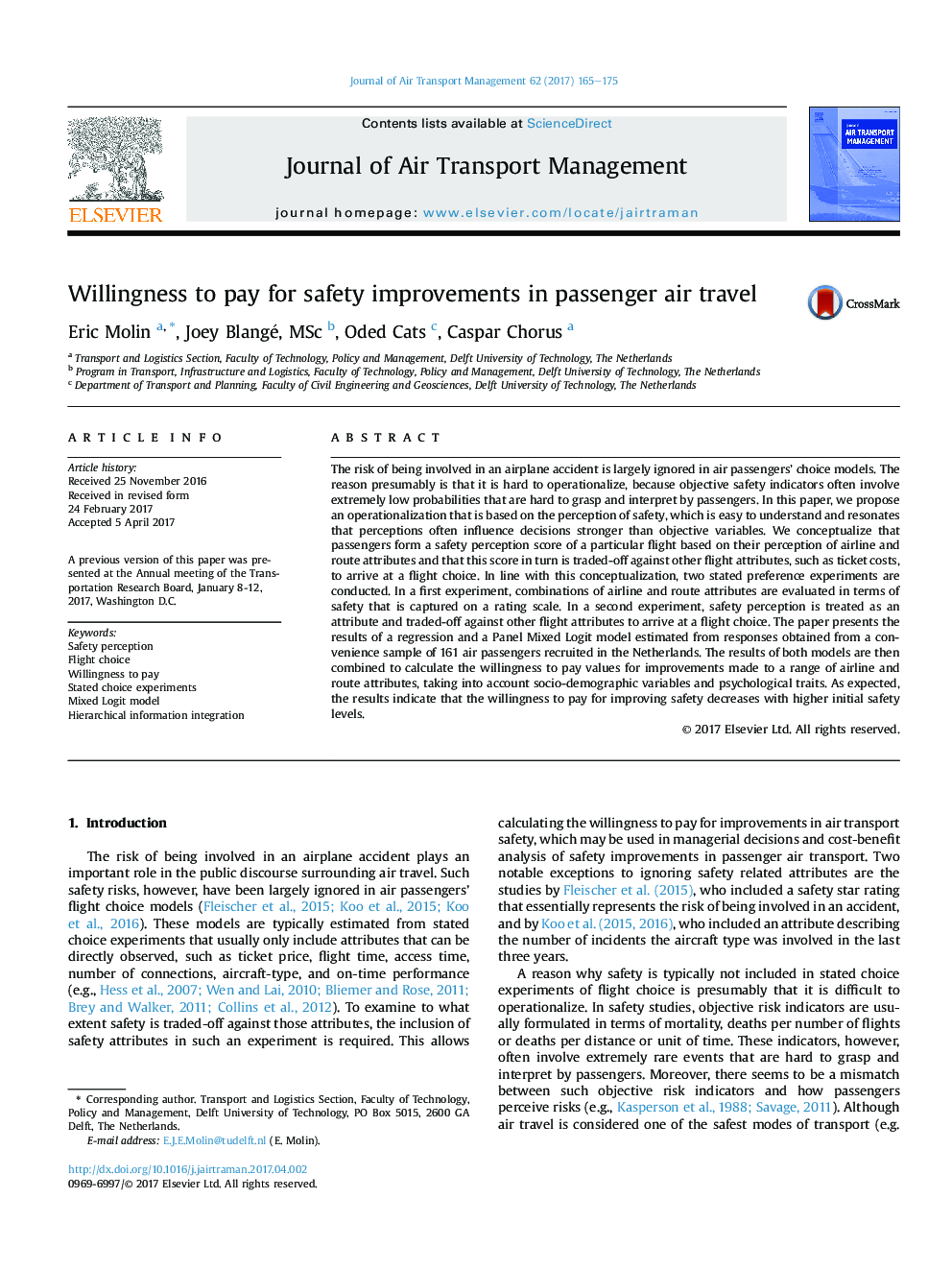| کد مقاله | کد نشریه | سال انتشار | مقاله انگلیسی | نسخه تمام متن |
|---|---|---|---|---|
| 5111474 | 1483557 | 2017 | 11 صفحه PDF | دانلود رایگان |
عنوان انگلیسی مقاله ISI
Willingness to pay for safety improvements in passenger air travel
ترجمه فارسی عنوان
آمادگی برای پرداخت هزینه های ایمنی در مسافرت هوایی
دانلود مقاله + سفارش ترجمه
دانلود مقاله ISI انگلیسی
رایگان برای ایرانیان
کلمات کلیدی
ترجمه چکیده
خطر ابتلا به تصادف در هواپیما در مدل های انتخابی مسافران هواپیما به شدت نادیده گرفته می شود. دلیل آن احتمالا این است که عملیات کردن سخت است، زیرا شاخص های ایمنی عینی اغلب شامل احتمال بسیار کم است که مسافران به راحتی درک و تفسیر می کنند. در این مقاله، ما پیشنهاد عملیاتی می کنیم که مبتنی بر درک ایمنی است که آسان است درک و رونق پیدا کند که ادراکات اغلب بر تصمیمات قوی تر از متغیرهای هدف تاثیر می گذارد. ما تصور می کنیم که مسافران یک امتیاز تصور ایمنی از یک پرواز خاص را بر اساس ادراک خود از ویژگی های خطوط هوایی و مسیر و این موضوع به نوبه خود در برابر سایر ویژگی های پرواز مانند هزینه های بلیط برای رسیدن به انتخاب پرواز معامله می شود. در راستای این مفهوم سازی، دو آزمایش تجربی ترجیح داده شده انجام می شود. در اولین آزمایش، ترکیبی از ویژگی های خطوط هوایی و مسیر از لحاظ ایمنی که در مقیاس رتبه بندی ثبت می شود، ارزیابی می شود. در یک آزمایش دوم، ادراک ایمنی به عنوان یک ویژگی شناخته می شود و در برابر سایر ویژگی های پرواز برای انتخاب پرواز انتخاب می شود. این مقاله نتایج یک مدل رگرسیون و یک مدل لجیت پانلی را که براساس پاسخ هایی که از نمونه ی مناسب 161 مسافر هواپیما استخدام شده در هلند بدست آمده است، برآورد می کند. نتایج هر دو مدل سپس برای محاسبه تمایل به پرداخت ارزش برای پیشرفت های انجام شده به طیف وسیعی از ویژگی های خطوط هوایی و مسیر، با توجه به متغیرهای اجتماعی-دموگرافیک و صفات روانی، محاسبه می شود. همانطور که انتظار می رود، نتایج نشان می دهد که تمایل به پرداخت هزینه برای بهبود ایمنی با سطح ایمنی اولیه بالاتر کاهش می یابد.
موضوعات مرتبط
علوم انسانی و اجتماعی
مدیریت، کسب و کار و حسابداری
استراتژی و مدیریت استراتژیک
چکیده انگلیسی
The risk of being involved in an airplane accident is largely ignored in air passengers' choice models. The reason presumably is that it is hard to operationalize, because objective safety indicators often involve extremely low probabilities that are hard to grasp and interpret by passengers. In this paper, we propose an operationalization that is based on the perception of safety, which is easy to understand and resonates that perceptions often influence decisions stronger than objective variables. We conceptualize that passengers form a safety perception score of a particular flight based on their perception of airline and route attributes and that this score in turn is traded-off against other flight attributes, such as ticket costs, to arrive at a flight choice. In line with this conceptualization, two stated preference experiments are conducted. In a first experiment, combinations of airline and route attributes are evaluated in terms of safety that is captured on a rating scale. In a second experiment, safety perception is treated as an attribute and traded-off against other flight attributes to arrive at a flight choice. The paper presents the results of a regression and a Panel Mixed Logit model estimated from responses obtained from a convenience sample of 161 air passengers recruited in the Netherlands. The results of both models are then combined to calculate the willingness to pay values for improvements made to a range of airline and route attributes, taking into account socio-demographic variables and psychological traits. As expected, the results indicate that the willingness to pay for improving safety decreases with higher initial safety levels.
ناشر
Database: Elsevier - ScienceDirect (ساینس دایرکت)
Journal: Journal of Air Transport Management - Volume 62, July 2017, Pages 165-175
Journal: Journal of Air Transport Management - Volume 62, July 2017, Pages 165-175
نویسندگان
Eric Molin, Joey MSc, Oded Cats, Caspar Chorus,
